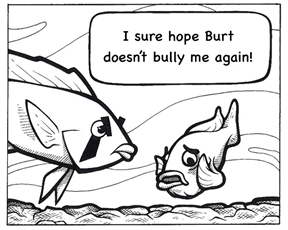Hormones, brain, and behavior – A review of SBN 2017!
Hi there! I just got back from sunny California where I attended the Society for Behavioral Neuroendocrinology (SBN) meeting! There was a lot of great research and I had a great time. I was especially excited to learn about some of the research being presented about me and my family. Check out a quick synopsis about the cichlid research that was presented at SBN 2017.
JULIE BUTLER: SOCIAL STATUS AND BEHAVIORAL CONTEXT REGULATE EXPRESSION AND ACTIVATION OF TACHYKININ3A NEURONS IN THE BRAIN OF A SOCIAL AFRICAN CICHLID FISH
Reproduction is really important. Neurons in my brain make sure that my reproductive system stays in tip-top shape. There’s this gene called tachykinin3 that helps regulate reproduction in mammals (like dogs, cats, and even humans!), but we don’t really know what it does in fish. Julie found that these neurons are located throughout my brain, not just in the one place that’s been so well studied in mammals. She also found that dominant males, like me, have more of these cells than subordinate guys. And she found that different groups of these cells are activated during different social behaviors. So when I chase off a subordinate, I use different sets of neurons than when I’m courting a female.SCOTT JUNTTI: DISSECTING FEMALE REPRODUCTIVE BEHAVIOR IN CICHLID FISH
You could say I’m the cool kid on the block. Scientists love to study me and my reproductive behaviors, but they kinda ignore Toni and female reproductive behavior. I guess Scott felt bad for her, so he started looking at the neuroendocrine control of female spawning behavior. He found that there’s this hormone, called prostaglandinF2a, that acts in the brain to induce spawning behaviors. Using this cool technique called CRISPR/cas9 that basically acts like tiny molecular scissors, he got rid of the PGF2a receptor in our brains. When he did that, it didn’t matter how much I tried to get Toni to spawn with me, she never did. It was depressing. Check out Scott’s paper here if you want to know more.TESSA SOLOMON-LANE: DEVELOPMENT ILLUMINATES VARIATION IN BEHAVIOR AND NEUROENDOCRINE FUNCTION
Things that happen to us when we’re little can causes changes in our adult behavior and physiology. Tessa is one of the few people to study our kids – most people only study adults, like Toni and me. She found that the little guys don’t establish typical social structures. So they don’t hold territories like I do. By putting baby fish into different environments – raising them in either pairs or large groups of other fish – she found impacts on their adult behaviors. Now she’s looking at their brains and hormones to see what may be causing those behavior changes.
BEAU ALWARD: ANDROGEN SIGNALING DURING SOCIAL ASCENT IS REQUIRED FOR COURTSHIP BUT NOT AGGRESSIVE BEHAVIORS IN AFRICAN CICHLIDSAs you know, I’m really territorial. When I first got my home, I “ascended” in social rank (check out this paper for more on social ascent). Beau wanted to know how hormones called androgens, like testosterone, are used for behaviors during this ascent. He injected us with a compound that blocks these hormones from binding to their receptors. When he did this, I didn’t court Toni anymore, but I had no problems defending my territory from other dudes. So these hormones are needed for courtship but not aggressive behaviors during social ascent.NICOLE M. BARAN: SPECIES DIFFERENCES IN AGGRESSIVE BEHAVIOR, NEURAL ACTIVITY, AND STEROID HORMONE RECEPTOR DISTRIBUTION IN LAKE MALAWI CICHLID FISH
Nicole presented a poster about some of my cousins: these guys are weird. They’re from another African lake called Lake Malawi, which is just south of Lake Tanganyika where I’m from. If you want to know more, check out her research and the Streelman lab. Some of these guys are from rocky areas while others are in sandy areas, and they have different levels of aggression depending on where they’re from. Nicole made them fight their reflection in a mirror (idiots!, although I’m embarrassed to say I do this too!) to look at aggression, and found that the guys from rocky areas are a lot more aggressive than those from sandy areas. She also took the brains from these guys to look at neural activation in brain regions involved in social behaviors. Her goal is to use these guys to look at how genes lead to species differences in brain and behavior.
Here’s a picture of some of the amazing cichlid scientists! Scott skipped out on the picture (I guess he’s too fancy with his real, big kid job as an assistant professor for them!).








Comments
Post a Comment